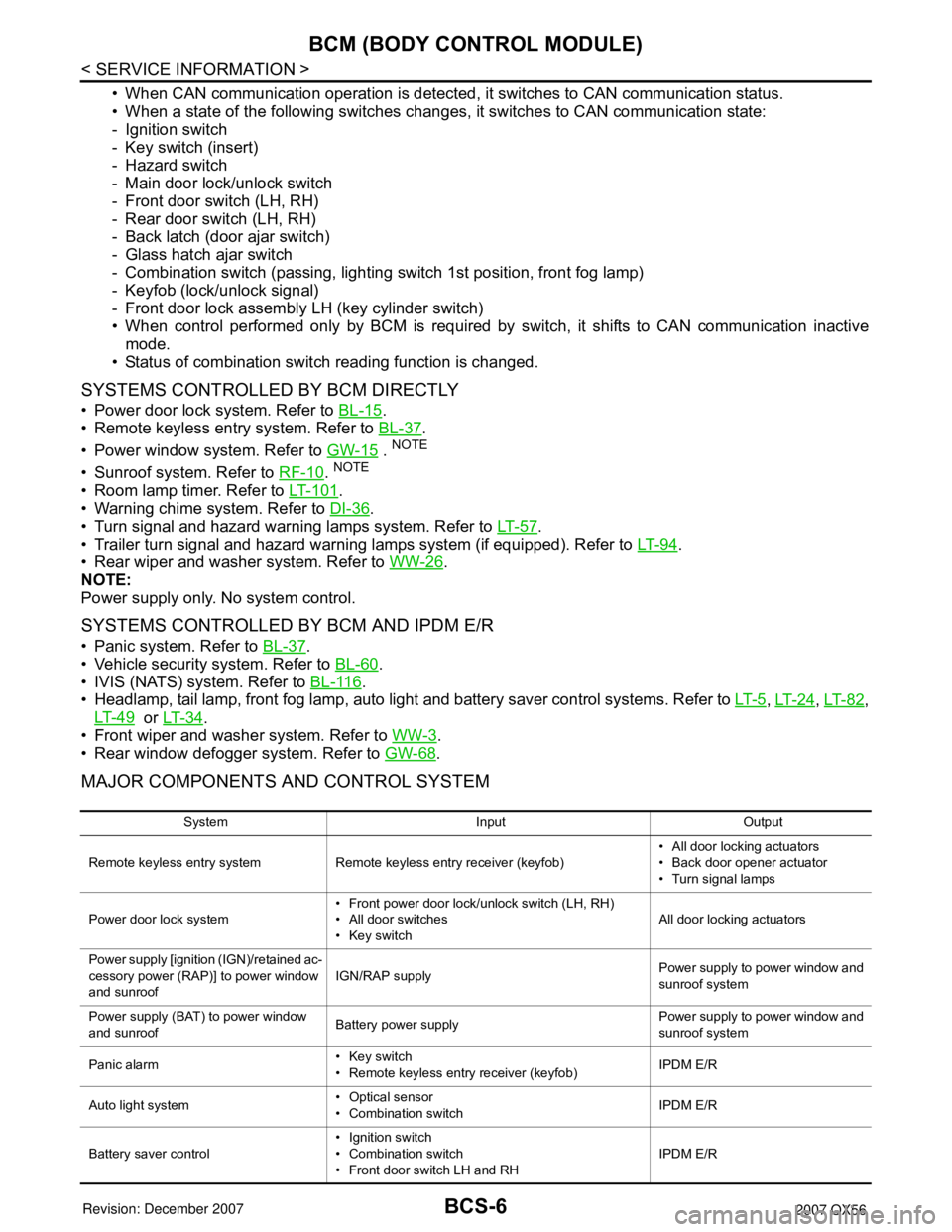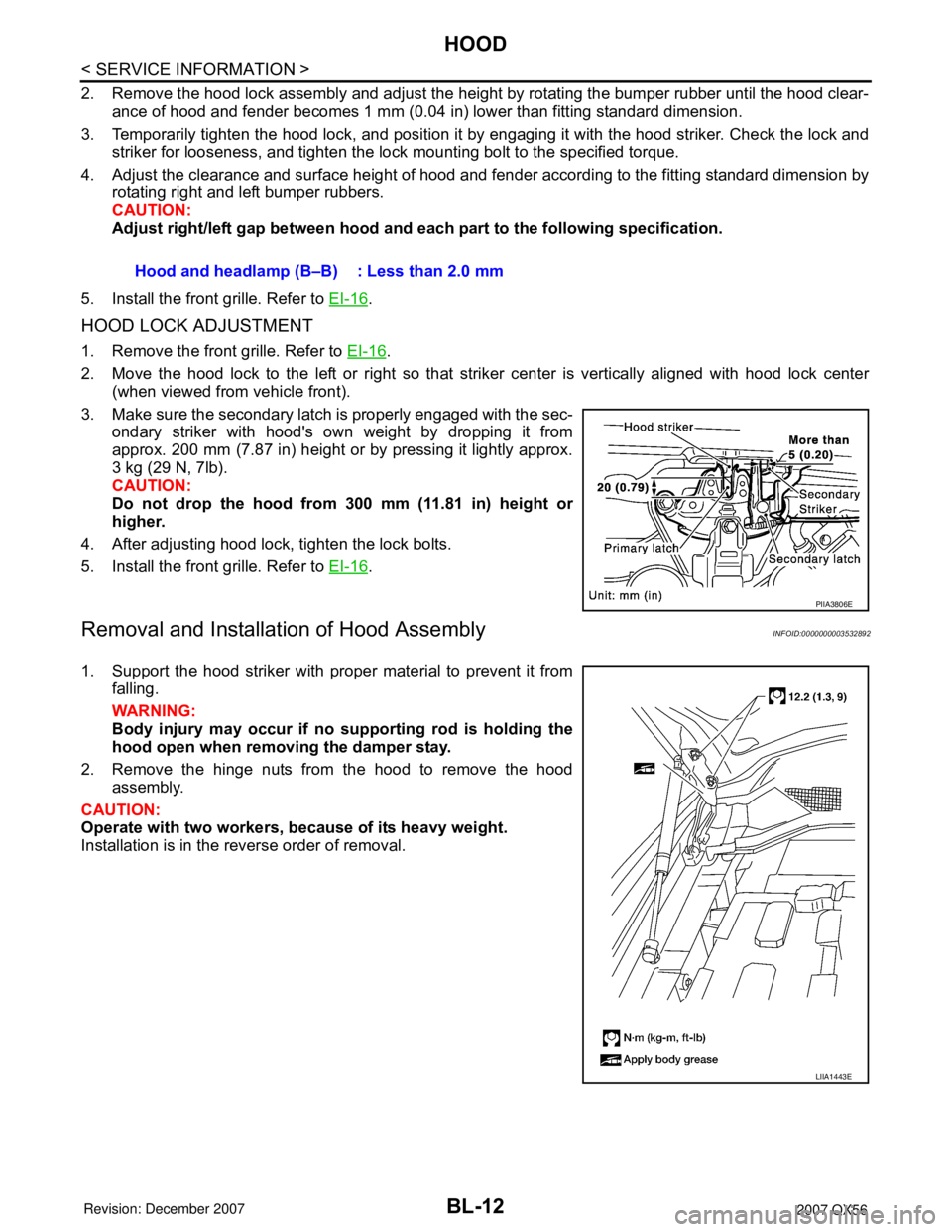Head light INFINITI QX56 2007 Factory Service Manual
[x] Cancel search | Manufacturer: INFINITI, Model Year: 2007, Model line: QX56, Model: INFINITI QX56 2007Pages: 3061, PDF Size: 64.56 MB
Page 19 of 3061
![INFINITI QX56 2007 Factory Service Manual ACS-6
< SERVICE INFORMATION >[ICC]
DESCRIPTION
DESCRIPTION
OutlineINFOID:0000000003533775
The Intelligent Cruise Control (ICC) system automatically maintains a selected distance from the vehicle
ahead INFINITI QX56 2007 Factory Service Manual ACS-6
< SERVICE INFORMATION >[ICC]
DESCRIPTION
DESCRIPTION
OutlineINFOID:0000000003533775
The Intelligent Cruise Control (ICC) system automatically maintains a selected distance from the vehicle
ahead](/img/42/57029/w960_57029-18.png)
ACS-6
< SERVICE INFORMATION >[ICC]
DESCRIPTION
DESCRIPTION
OutlineINFOID:0000000003533775
The Intelligent Cruise Control (ICC) system automatically maintains a selected distance from the vehicle
ahead according to that vehicle's speed, or at the set speed, if the road ahead is clear.
The ICC function has two cruise control modes and brake assist (with preview function). The ICC system may
AUTO-CANCEL for various reasons, for example, when the windshield wipers are operating.
VEHICLE-TO-VEHICLE DISTANCE CONTROL MODE
Vehicle-to-vehicle distance control mode, the same speed as other vehicles, can be maintained without the
constant need to adjust the operating speed as with a conventional cruise control system.
The system is intended to enhance the operation of the vehicle when following another vehicle in the same
lane and direction.
If the distance sensor detects a slower moving vehicle ahead, the system will reduce speed so that the vehicle
ahead can be followed at the selected distance.
The system automatically controls the throttle and applies the brakes (up to 25% of vehicle braking power) if
necessary.
The detection range of the sensor is approximately 120 m (390 ft) ahead.
Refer to Owner's Manual for Intelligent Cruise Control System operating instructions.
CONVENTIONAL (FIXED SPEED) CRUISE CONTROL MODE
Conventional (fixed speed) cruise control mode is cruising at preset speeds.
Refer to Owner's Manual for Intelligent Cruise Control System operation instructions.
BRAKE ASSIST (WITH PREVIEW FUNCTION)
When the force applied to brake pedal exceeds a certain level, the brake assist is activated and generates a
greater braking force than that of a conventional brake booster, even with light pedal force.
When the preview function identifies the need to apply the sudden brake by sensing the vehicle ahead in the
same lane and the distance and relative speed from it, it applies the brake pre-pressure before driver
depresses the brake pedal and improves brake response by reducing its free play.
Refer to Owner's Manual for Intelligent Cruise Control System operating instructions.
SchematicINFOID:0000000003533776
WKIA1976E
Page 21 of 3061
![INFINITI QX56 2007 Factory Service Manual ACS-8
< SERVICE INFORMATION >[ICC]
DESCRIPTION
ICC System Display
INFOID:0000000003533780
4 CANCEL switch Deactivates system without erasing set speed.
5 DISTANCE switch Changes the following distance INFINITI QX56 2007 Factory Service Manual ACS-8
< SERVICE INFORMATION >[ICC]
DESCRIPTION
ICC System Display
INFOID:0000000003533780
4 CANCEL switch Deactivates system without erasing set speed.
5 DISTANCE switch Changes the following distance](/img/42/57029/w960_57029-20.png)
ACS-8
< SERVICE INFORMATION >[ICC]
DESCRIPTION
ICC System Display
INFOID:0000000003533780
4 CANCEL switch Deactivates system without erasing set speed.
5 DISTANCE switch Changes the following distance from: Long, Middle, Short. No. Switch name Description
WKIA1977E
No. Component Description
1 Set vehicle speed indicator Indicates the set vehicle speed.
2 Vehicle ahead detection indicator Indicates whether it detects a vehicle ahead.
3 Set distance indicatorDisplay the selected distance between vehicles set with the DISTANCE
switch.
4 Own vehicle indicator Indicates the base vehicle.
5 ON/OFF switch indicator lamp (Green) Indicates that the system is ON.
6Intelligent cruise control system warning
lamp (Orange)The light comes on if there is a malfunction in the ICC system.
7 Cruise set switch indicator lamp Indicates that the conventional cruise control mode is on.
Page 565 of 3061

AUDIO
AV-25
< SERVICE INFORMATION >
C
D
E
F
G
H
I
J
L
MA
B
AV
N
O
P
Terminal and Reference Value for Rear Audio Remote Control UnitINFOID:0000000003533669
28 (Y) 27 (BR)Audio sound
signal front RHInput ONReceive audio
signalNo sound from
front door speaker
RH or front tweeter
RH.
30 (W) 29 (B)Audio sound
signal front LHInput ONReceive audio
signalNo sound from
front door speaker
LH or front tweeter
LH.
31 (G/W) GroundAmp. ON sig-
nalInput ON – More than 6.5VSystem does not
work properly. Te r m i n a l
(wire color)
ItemSignal
input/
outputCondition
Reference value
(Approx.)Example of
symptom
+–Ignition
switchOperation
SKIA0177E
SKIA0177E
Te r m i n a l
(Wire color)
ItemSignal
input/
outputCondition
Reference value
(Approx.)Example of symptom
+–Ignition
switchOperation
2 (G) 1 (B)Audio sound
signal LHInput ONReceive audio
signalNo sound from LH
headphone channel.
4 (W) 3 (R)Audio sound
signal RHInput ONReceive audio
signalNo sound from RH
headphone channel.
5 – Shield – – – 0VInterference and dis-
tortion heard from
headphones or rear
audio remote control
unit switches not op-
erating properly.
6 (R/L) Ground Illumination Input ONLighting switch
ON12V
Rear audio remote
control unit does not
illuminate. Lighting switch
OFF0V
7 (LG) –Remote
control
ground–– – 0VRear audio remote
control unit switches
do not function.
SKIA0177E
SKIA0177E
Page 691 of 3061

BCS-4
< SERVICE INFORMATION >
BCM (BODY CONTROL MODULE)
NOTE:
Headlamp has a dual system switch.
4. Example operation: (When lighting switch 1st position turned ON)
• When lighting switch 1st position is turned ON, contact in combination switch turns ON. At this time if
OUTPUT 4 transistor is activated, BCM detects that voltage changes in INPUT 5.
• When OUTPUT 4 transistor is ON, BCM detects that voltage changes in INPUT 5, and judges lighting
switch 1st position is ON. Then BCM sends tail lamp ON signal to IPDM E/R using CAN communication.
• When OUTPUT 4 transistor is activated again, BCM detects that voltage changes in INPUT 5 and rec-
ognizes that lighting switch 1st position is continuously ON.
NOTE:
Each OUTPUT terminal transistor is activated at 10ms intervals. Therefore, after a switch is turned ON,
electrical loads are activated with a time delay. But this time delay is so short that it cannot be noticed.
5. Operation mode
• Combination switch reading function has operation modes as follows:
SKIA4959E
LIIA0760E
Page 693 of 3061

BCS-6
< SERVICE INFORMATION >
BCM (BODY CONTROL MODULE)
• When CAN communication operation is detected, it switches to CAN communication status.
• When a state of the following switches changes, it switches to CAN communication state:
- Ignition switch
- Key switch (insert)
- Hazard switch
- Main door lock/unlock switch
- Front door switch (LH, RH)
- Rear door switch (LH, RH)
- Back latch (door ajar switch)
- Glass hatch ajar switch
- Combination switch (passing, lighting switch 1st position, front fog lamp)
- Keyfob (lock/unlock signal)
- Front door lock assembly LH (key cylinder switch)
• When control performed only by BCM is required by switch, it shifts to CAN communication inactive
mode.
• Status of combination switch reading function is changed.
SYSTEMS CONTROLLED BY BCM DIRECTLY
• Power door lock system. Refer to BL-15.
• Remote keyless entry system. Refer to BL-37
.
• Power window system. Refer to GW-15
. NOTE
• Sunroof system. Refer to RF-10. NOTE
• Room lamp timer. Refer to LT-101.
• Warning chime system. Refer to DI-36
.
• Turn signal and hazard warning lamps system. Refer to LT- 5 7
.
• Trailer turn signal and hazard warning lamps system (if equipped). Refer to LT- 9 4
.
• Rear wiper and washer system. Refer to WW-26
.
NOTE:
Power supply only. No system control.
SYSTEMS CONTROLLED BY BCM AND IPDM E/R
• Panic system. Refer to BL-37.
• Vehicle security system. Refer to BL-60
.
• IVIS (NATS) system. Refer to BL-116
.
• Headlamp, tail lamp, front fog lamp, auto light and battery saver control systems. Refer to LT- 5
, LT- 2 4, LT- 8 2,
LT- 4 9
or LT- 3 4.
• Front wiper and washer system. Refer to WW-3
.
• Rear window defogger system. Refer to GW-68
.
MAJOR COMPONENTS AND CONTROL SYSTEM
System Input Output
Remote keyless entry system Remote keyless entry receiver (keyfob)• All door locking actuators
• Back door opener actuator
• Turn signal lamps
Power door lock system• Front power door lock/unlock switch (LH, RH)
• All door switches
• Key switchAll door locking actuators
Power supply [ignition (IGN)/retained ac-
cessory power (RAP)] to power window
and sunroofIGN/RAP supplyPower supply to power window and
sunroof system
Power supply (BAT) to power window
and sunroofBattery power supplyPower supply to power window and
sunroof system
Panic alarm• Key switch
• Remote keyless entry receiver (keyfob)IPDM E/R
Auto light system• Optical sensor
• Combination switchIPDM E/R
Battery saver control• Ignition switch
• Combination switch
• Front door switch LH and RHIPDM E/R
Page 694 of 3061

BCM (BODY CONTROL MODULE)
BCS-7
< SERVICE INFORMATION >
C
D
E
F
G
H
I
J
L
MA
B
BCS
N
O
P
CAN Communication System DescriptionINFOID:0000000003533597
Refer to LAN-4.
Headlamp Combination switch IPDM E/R
Tail lamp Combination switch IPDM E/R
Front fog lamp Combination switch IPDM E/R
Turn signal lamp Combination switch• Turn signal lamp
• Combination meter
Hazard lamp Hazard switch• Turn signal lamp
• Combination meter
Room lamp timer• Key switch
• Remote keyless entry receiver (keyfob)
• Main power window and door lock/unlock switch
• Front door lock assembly LH (key cylinder switch)
• All door switchesInterior room lamp
Key warning chime• Key switch
• Front door switch LHCombination meter (warning buzz-
er)
Light warning chime• Combination switch
• Key switch
• Front door switch LHCombination meter (warning buzz-
er)
Vehicle-speed-sensing intermittent wip-
er• Combination switch
• Combination meterIPDM E/R
Rear window defogger Rear window defogger switch IPDM E/R
Air conditioner switch signal Front air control ECM
Blower fan switch signal Front air control ECM
Low tire pressure warning system Remote keyless entry receiver• Combination meter
• Display control unit
Trailer tow (if equipped) Combination switch Trailer turn signal relays
Vehicle security system• Remote keyless entry receiver (keyfob)
• Main power window and door lock/unlock switch
• Power window and door lock/unlock switch RH
• Front door lock assembly LH (key cylinder switch)
• All door switches
• Back door latch (door ajar switch)• IPDM E/R
• Security indicator lamp System Input Output
Page 719 of 3061

BL-8
< SERVICE INFORMATION >
SQUEAK AND RATTLE TROUBLE DIAGNOSIS
Most of these incidents can be repaired by adjusting, securing or insulating the item(s) or component(s) caus-
ing the noise.
SUNROOF/HEADLINING
Noises in the sunroof/headlining area can often be traced to one of the following:
1. Sunroof lid, rail, linkage or seals making a rattle or light knocking noise
2. Sun visor shaft shaking in the holder
3. Front or rear windshield touching headliner and squeaking
Again, pressing on the components to stop the noise while duplicating the conditions can isolate most of these
incidents. Repairs usually consist of insulating with felt cloth tape.
OVERHEAD CONSOLE (FRONT AND REAR)
Overhead console noises are often caused by the console panel clips not being engaged correctly. Most of
these incidents are repaired by pushing up on the console at the clip locations until the clips engage.
In addition look for:
1. Loose harness or harness connectors.
2. Front console map/reading lamp lense loose.
3. Loose screws at console attachment points.
SEATS
When isolating seat noise it's important to note the position the seat is in and the load placed on the seat when
the noise is present. These conditions should be duplicated when verifying and isolating the cause of the
noise.
Cause of seat noise include:
1. Headrest rods and holder
2. A squeak between the seat pad cushion and frame
3. The rear seatback lock and bracket
These noises can be isolated by moving or pressing on the suspected components while duplicating the con-
ditions under which the noise occurs. Most of these incidents can be repaired by repositioning the component
or applying urethane tape to the contact area.
UNDERHOOD
Some interior noise may be caused by components under the hood or on the engine wall. The noise is then
transmitted into the passenger compartment.
Causes of transmitted underhood noise include:
1. Any component mounted to the engine wall
2. Components that pass through the engine wall
3. Engine wall mounts and connectors
4. Loose radiator mounting pins
5. Hood bumpers out of adjustment
6. Hood striker out of adjustment
These noises can be difficult to isolate since they cannot be reached from the interior of the vehicle. The best
method is to secure, move or insulate one component at a time and test drive the vehicle. Also, engine RPM
or load can be changed to isolate the noise. Repairs can usually be made by moving, adjusting, securing, or
insulating the component causing the noise.
Page 723 of 3061

BL-12
< SERVICE INFORMATION >
HOOD
2. Remove the hood lock assembly and adjust the height by rotating the bumper rubber until the hood clear-
ance of hood and fender becomes 1 mm (0.04 in) lower than fitting standard dimension.
3. Temporarily tighten the hood lock, and position it by engaging it with the hood striker. Check the lock and
striker for looseness, and tighten the lock mounting bolt to the specified torque.
4. Adjust the clearance and surface height of hood and fender according to the fitting standard dimension by
rotating right and left bumper rubbers.
CAUTION:
Adjust right/left gap between hood and each part to the following specification.
5. Install the front grille. Refer to EI-16
.
HOOD LOCK ADJUSTMENT
1. Remove the front grille. Refer to EI-16.
2. Move the hood lock to the left or right so that striker center is vertically aligned with hood lock center
(when viewed from vehicle front).
3. Make sure the secondary latch is properly engaged with the sec-
ondary striker with hood's own weight by dropping it from
approx. 200 mm (7.87 in) height or by pressing it lightly approx.
3 kg (29 N, 7lb).
CAUTION:
Do not drop the hood from 300 mm (11.81 in) height or
higher.
4. After adjusting hood lock, tighten the lock bolts.
5. Install the front grille. Refer to EI-16
.
Removal and Installation of Hood AssemblyINFOID:0000000003532892
1. Support the hood striker with proper material to prevent it from
falling.
WARNING:
Body injury may occur if no supporting rod is holding the
hood open when removing the damper stay.
2. Remove the hinge nuts from the hood to remove the hood
assembly.
CAUTION:
Operate with two workers, because of its heavy weight.
Installation is in the reverse order of removal.Hood and headlamp (B–B) : Less than 2.0 mm
PIIA3806E
LIIA1443E
Page 766 of 3061

REMOTE KEYLESS ENTRY SYSTEM
BL-55
< SERVICE INFORMATION >
C
D
E
F
G
H
J
K
L
MA
B
BL
N
O
P
Check voltage between IPDM E/R connector E122 terminal 45 and
ground.
OK or NG
OK >> Replace IPDM E/R.
NG >> GO TO 2.
2.CHECK IPDM E/R INPUT VOLTAGE
1. Turn ignition switch OFF.
2. Disconnect IPDM E/R and horn relay.
3. Check continuity between IPDM E/R connector E122 terminal
45 and horn relay connector H-1 terminal 1.
4. Check continuity between IPDM E/R connector E122 terminal
45 and ground.
OK or NG
OK >> Further inspection is necessary. Refer to BL-47, "Trou-
ble Diagnosis".
NG >> Repair or replace harness
Check Hazard FunctionINFOID:0000000003532932
1.CHECK HAZARD WARNING LAMP
Does hazard indicator flash with hazard switch?
Ye s o r N o
Yes >> Hazard warning lamp circuit is OK.
No >> Check hazard indicator. Refer to LT- 5 7
.
Check Horn FunctionINFOID:0000000003532933
First, perform the "SELF-DIAG RESULTS" in "BCM" with CONSULT-II, then perform the trouble diagnosis of
malfunction system indicated in "SELF-DIAG RESULTS" of "BCM".
1.CHECK HORN FUNCTION
Does horn sound with horn switch?
Ye s o r N o
Yes >> Horn circuit is OK.
No >> Check horn circuit. Refer to WW-43
.
Check Headlamp FunctionINFOID:0000000003532934
First, perform the "SELF-DIAG RESULTS" in "BCM" with CONSULT-II, then perform the trouble diagnosis of
malfunction system indicated in "SELF-DIAG RESULTS" of "BCM".
1.CHECK HEADLAMP OPERATION
Does headlamp come on when turning lighting switch ON?
Ye s o r N o
Yes >> Headlamp operation circuit is OK.
No >> Check headlamp circuit. Refer to LT- 5
.
ConnectorTe r m i n a l s
Voltage (V)
(Approx.)
(+) (–)
E122 45 Ground Battery voltage
LIIA1053E
45 - 1 : Continuity should exist.
45 - Ground : Continuity should not exist.
WIIA0679E
Page 790 of 3061

VEHICLE SECURITY (THEFT WARNING) SYSTEM
BL-79
< SERVICE INFORMATION >
C
D
E
F
G
H
J
K
L
MA
B
BL
N
O
P
Check continuity between main power window and door lock/unlock
switch connector (A) D7 terminals 4, 6 and front door lock assembly
LH (key cylinder switch) connector (B) D14 terminals 1, 6 and body
ground.
OK or NG
OK >> Replace main power window and door lock/unlock switch.
NG >> Repair or replace harness.
Vehicle Security Horn Alarm CheckINFOID:0000000003532953
1.CHECK HORN OPERATION
Check if horn sounds with horn switch.
Does horn operate?
YES >> Check harness for open or short between IPDM E/R and horn relay.
NO >> Check horn circuit. Refer to WW-43
.
Vehicle Security Headlamp Alarm CheckINFOID:0000000003532954
1.CHECK VEHICLE SECURITY HEADLAMP ALARM OPERATION
Check if headlamps operate with lighting switch.
Do headlamps come on when turning switch ON?
YES >> Headlamp alarm is OK.
NO >> Check headlamp system. Refer to LT- 5
or LT- 2 4.
Door Lock/Unlock Switch CheckINFOID:0000000003532955
1.CHECK DOOR LOCK/UNLOCK SWITCH INPUT SIGNAL
Check if power door lock operates with door lock/unlock switch.
Do doors lock/unlock when using each door lock/unlock switch?
YES >> Door lock/unlock switch is OK.
NO >> Refer to "Door Lock/Unlock Switch Check ".
Connector Terminals Connector Terminals Continuity
A: Main
power win-
dow and
door lock/
unlock
switch4 B: Front
door lock
assembly
LH (key
cylinder
switch)1Yes
66Yes
4, 6 Ground No
WIIA0756E